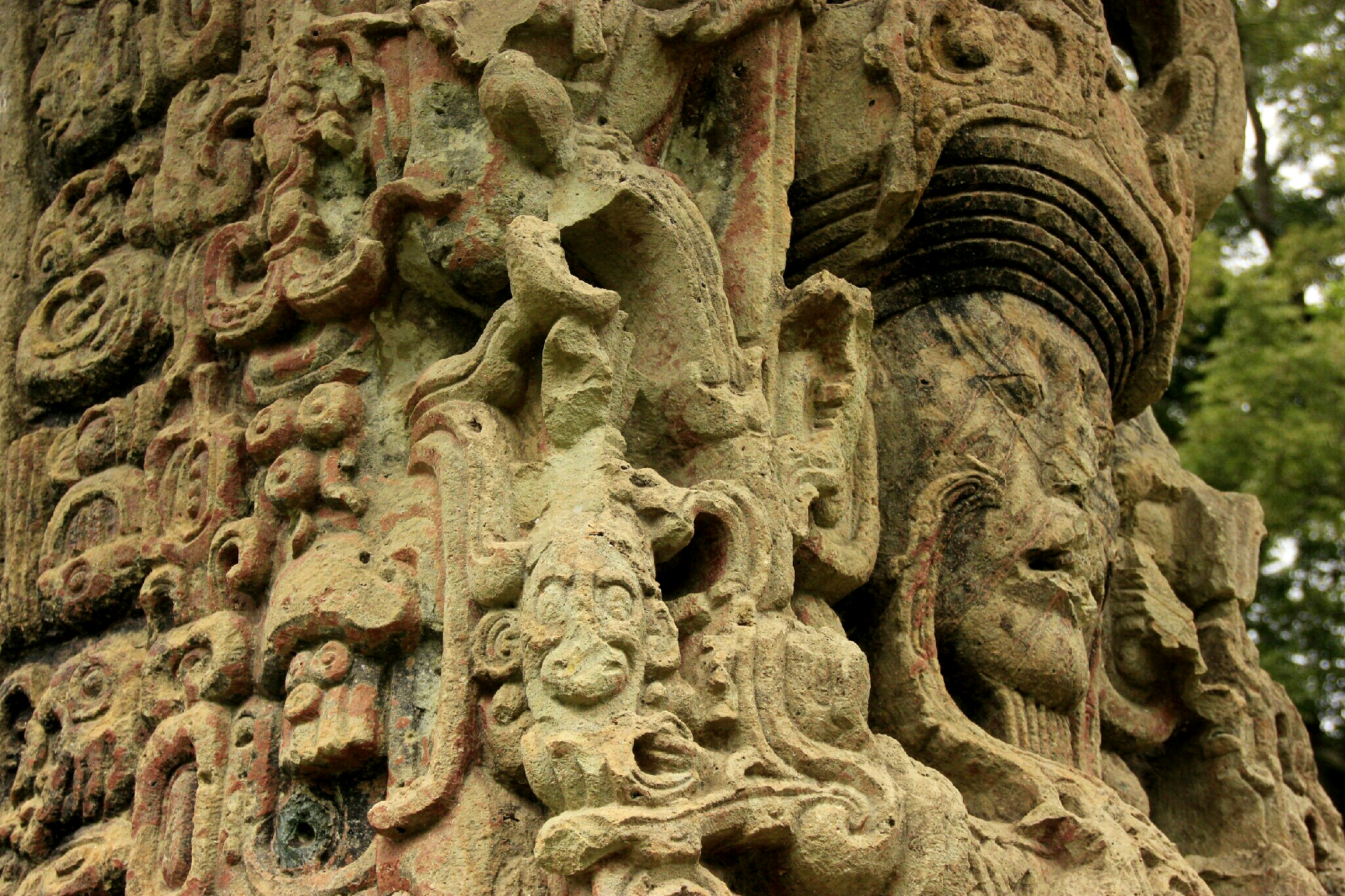
After we had decided to leave Utila island again we boarded the tiny ferry another time and headed back to La Ceiba on a much calmer sea this time. From there we embarked upon another long and costly trip in a freezing bus to Copan Ruinas which is only 12 km away from the border to Guatemala. According to our travel guide it is the culturally most important place to visit in Honduras since the amazing ruins of the Maya city Copan can be explored there. They are situated one kilometer outside of the pretty little town of Copan Ruinas that has to thank the archaeological heritage of it’s Maya ancestors for it’s name as well as it’s main source of income.
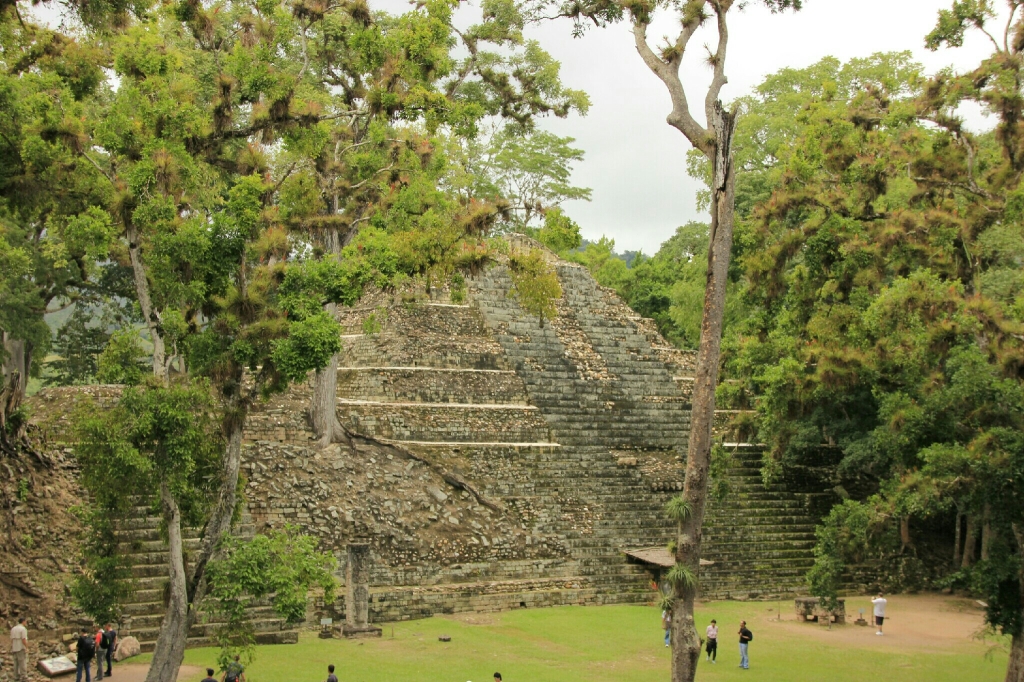
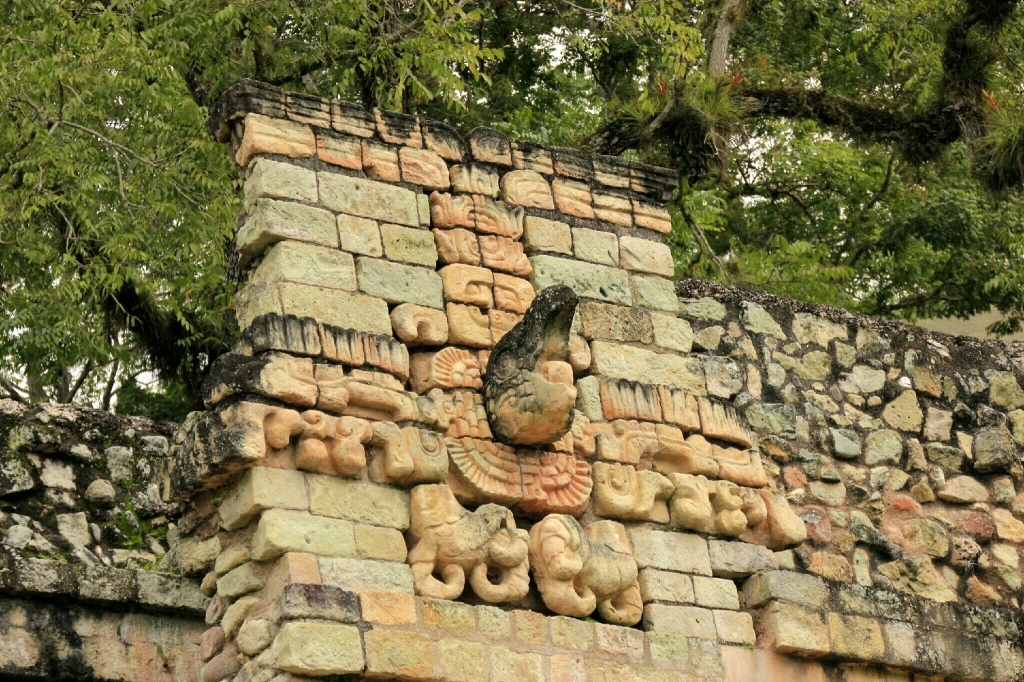
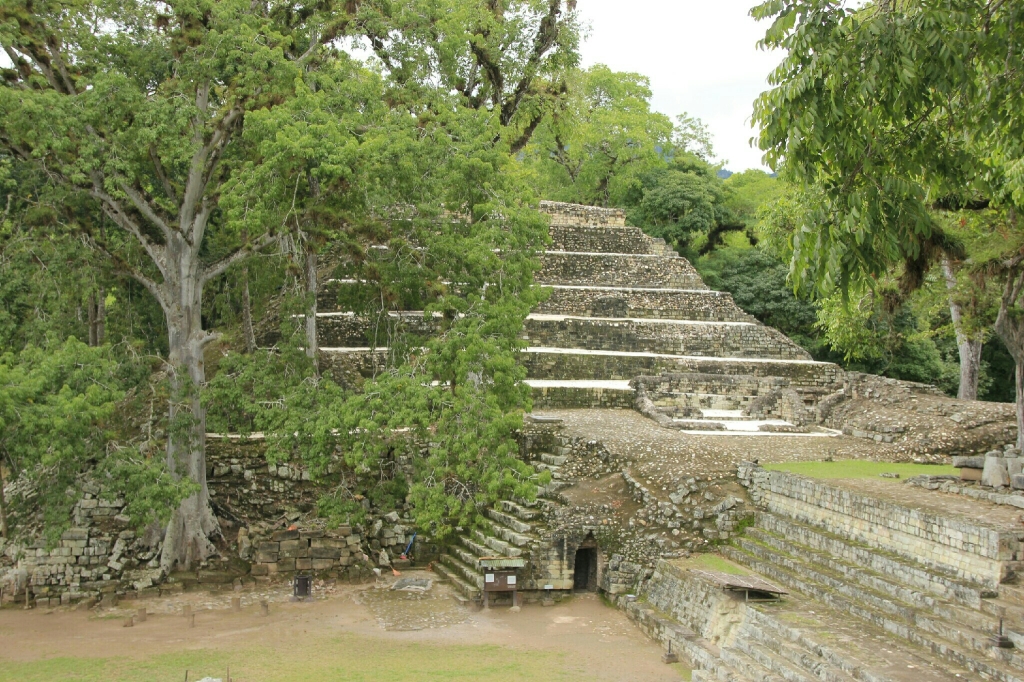
Copan existed at the most south-eastern corner of the Maya realm and is mainly renowned for the most exceptional level of detail and artistry of the inscriptions and stelae found there. The highly sophisticated culture of the Maya should be known to most people at least since there was some silly hysteria in 2012 about a turning point of the Mayan calendar. Others may have heard of the Mayas as the inventors of chocolate or builders of pyramids or maybe even because of their practice of human sacrifices. Curiously they knew the wheel but didn’t use it and that in spite of them having no animals available that could be used for transporting purposes. The enormous amounts of stones they needed for all of their buildings have been solely moved by human labour. The Mayas also didn’t know about arches or vaults so their buildings look very angled. Even their pictorial representations made us think a few times that the depicted persons just had their strange contorted poses in order to fit into a rectangle.
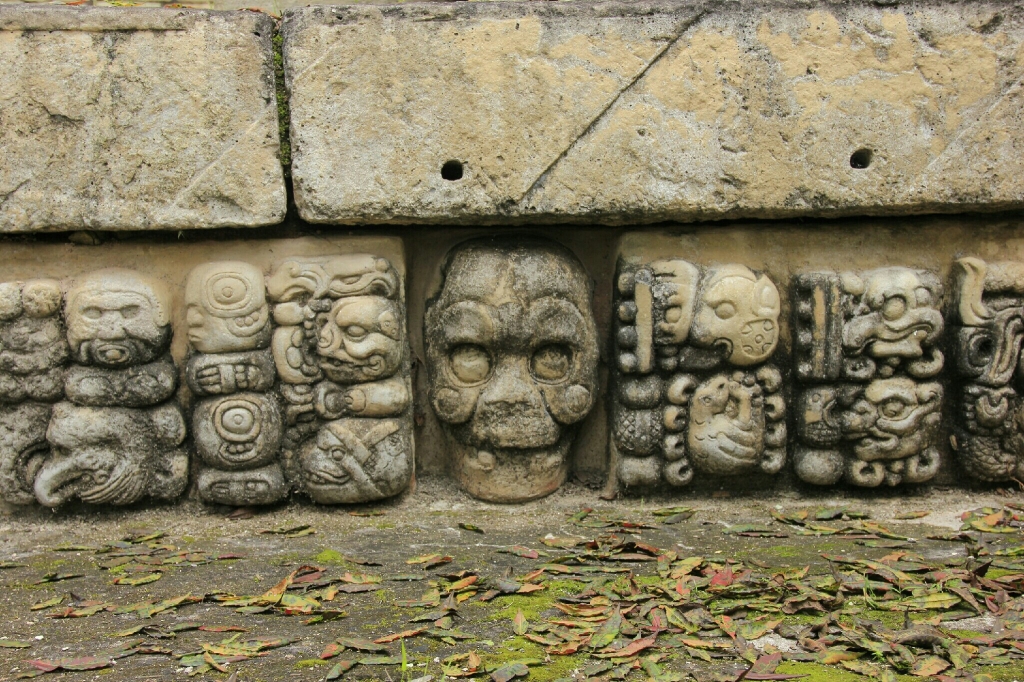

At the entrance of the Copan ruins you are greeted by macaws that were very common in the area in ancient times. They also had a strong influence on the Mayan culture and can be found in their mythology and architecture. Regretfully there’s not many of them left nowadays so a project has been started to repopulate the Copan valley with this beautiful big birds. Before they are sent out to live on their own they get feeded regularly in the archaeological park so they are quite used to humans and you can get pretty close to them.
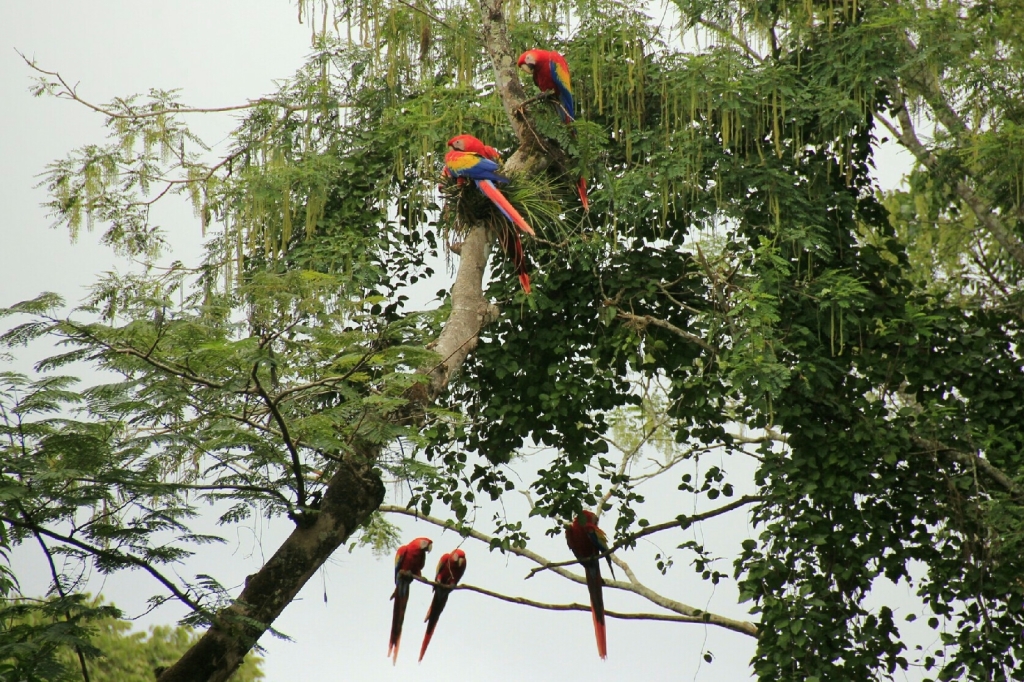
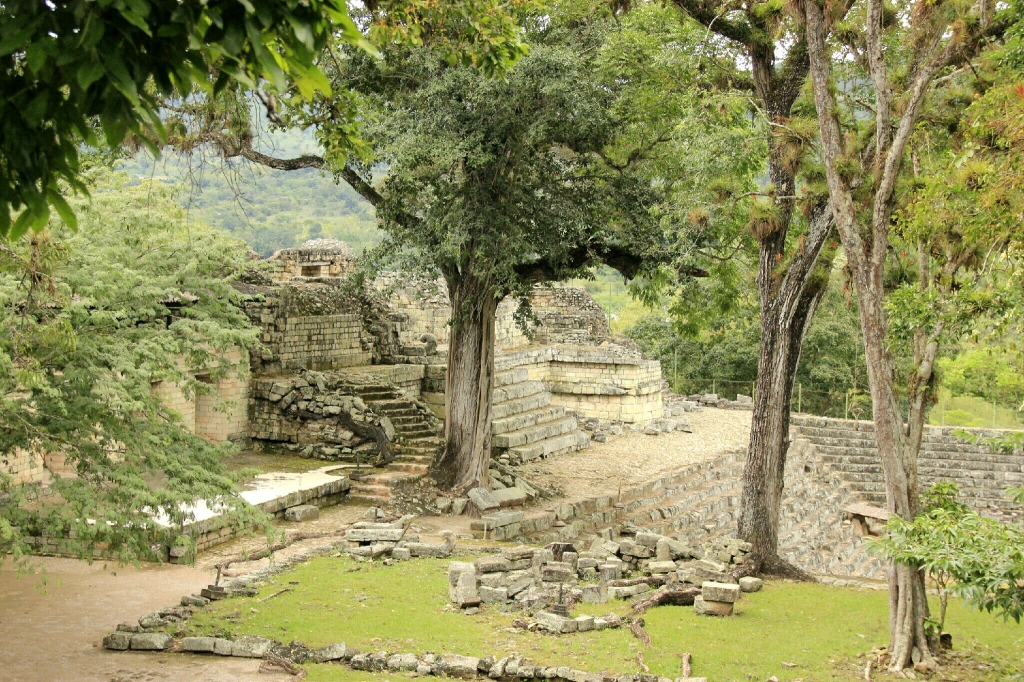
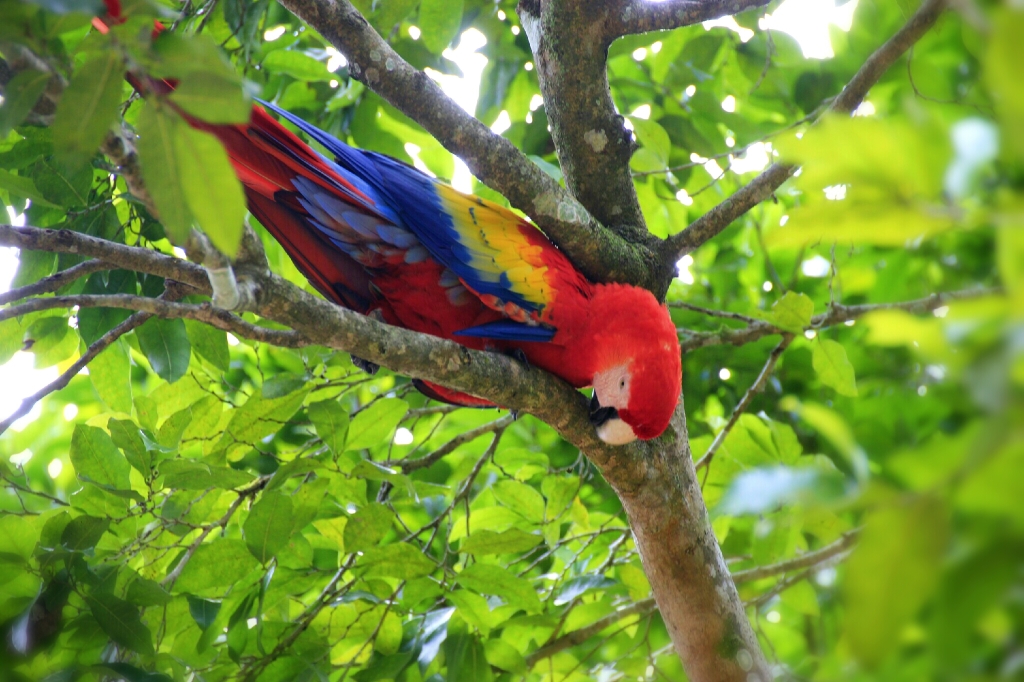
The local guides that can also be found and hired at the entrance of the ruins all carry long sticks with long, colourful feathers that the macaws sometimes lose tied to one end. One of the guides who seemed to be very old wanted to know where we come from and then went ahead to impress us and his two customers with some sentences of surprisingly good german. Luckily there were only a few visitors in the ruin-park and most of them came from Honduras as we saw in the guestbook.
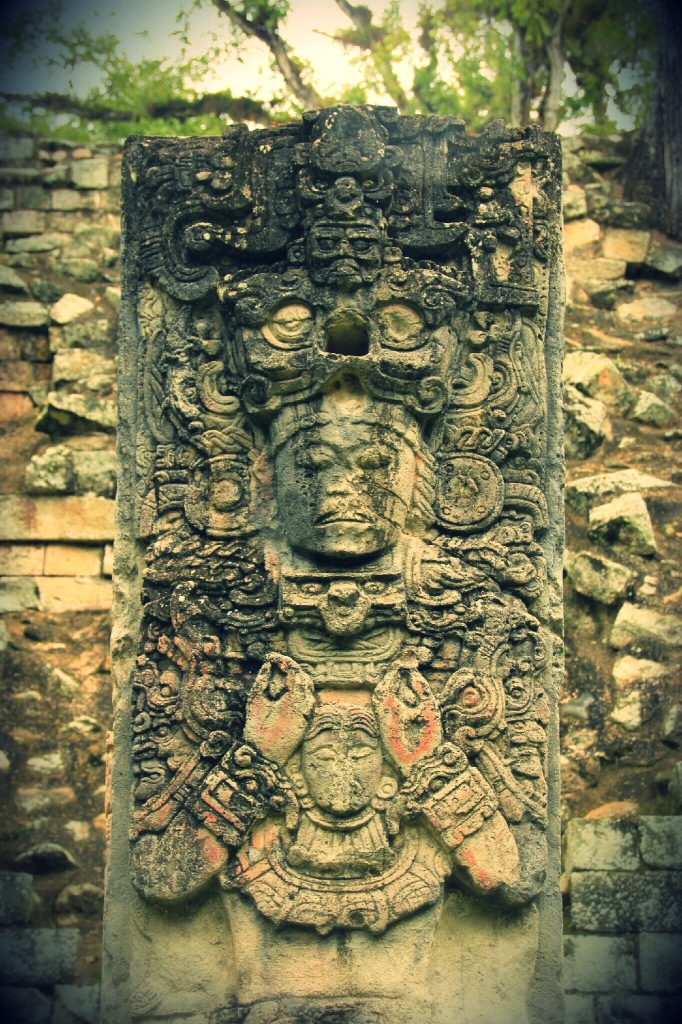
Copan was a city-state that existed from around the year 250 until 900 when the Maya realm suddenly broke apart for largely unknown reasons. The ruins of it’s centre are still very impressive today. In the city itself there were a supposed 6000 to 9000 inhabitants during it’s peak time and in the whole valley of Copan all in all about 25000 people lived. The rulers of this realm had mysterious and strong names like “smoke jaguar” or “smoke shell” but also rather puzzling ones like “18 rabbit” who is depicted on quite some of the stelae and who was responsible for some of the most important buildings of Copan. Supposedly the language of the Mayan hieroglyphs has beend largely decrypted but we also read that some texts are only understood roughly and especially king “18 rabbit” made us wonder how correct some of the translations really are. What is remarkable though is that the Mayas were the only ones who had a fully developed written language in all of America until the arrival of the Spanish. The most remarkable feature of the Copan ruins are the large stairs covered in hieroglyphs that tell the history of the city in more than 2000 signs. This consists the longest Mayan text that is known and therefore it’s unique in the world. Unfortunately an earthquake has knocked most of the steps loose in the last century and they have been put together in a wrong order afterwards. That’s why archaeologists still try to figure out the precise text by using some old photographs of the stairs.
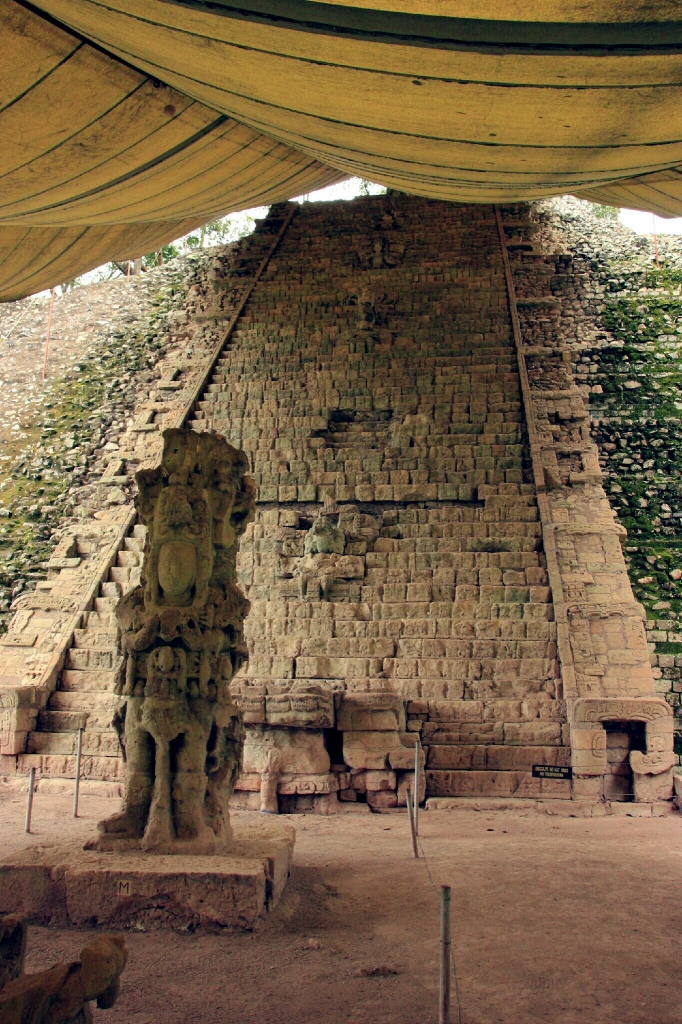
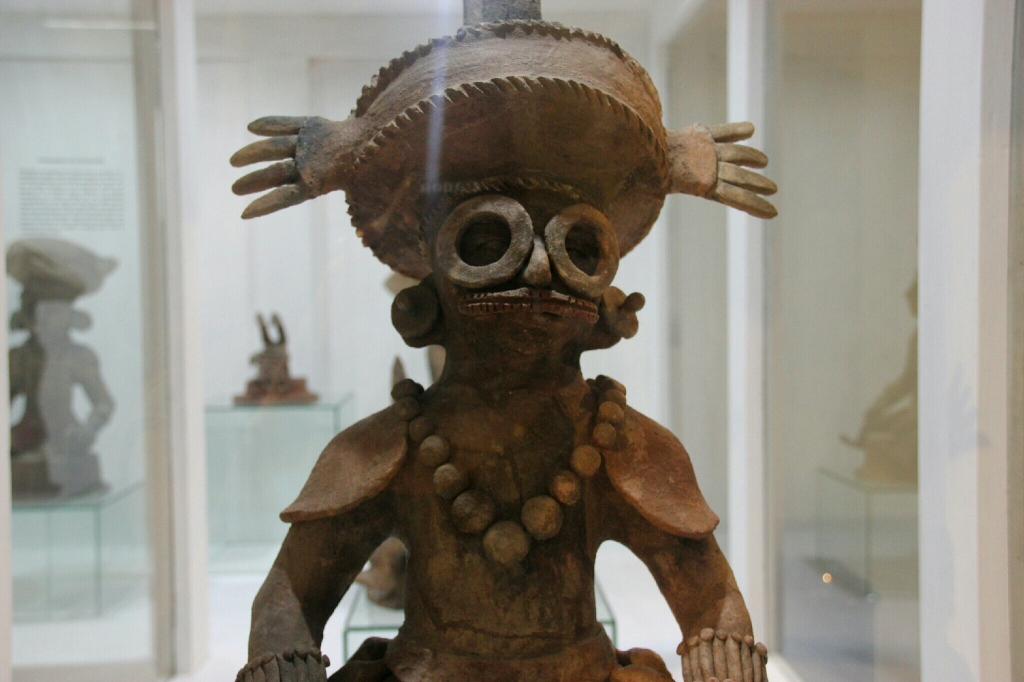

In contrary to the egyptian pyramids those of the Mayas weren’t used as tombs primarily. They fulffiled mostly religious purposes, e.g. as places where sacrifices were made. Religion played a major role in the life of the Mayas and actually most of the buildings whose ruins one can still see today in Copan had religious purposes, instead of being places to live. To the north and south of the city centre you can see remains of buildings where the upper lass of Copan lived though. Another short walk of about 1 kilometer brings you yo “Las Sepulturas”, where also the Copan nobility once resided.
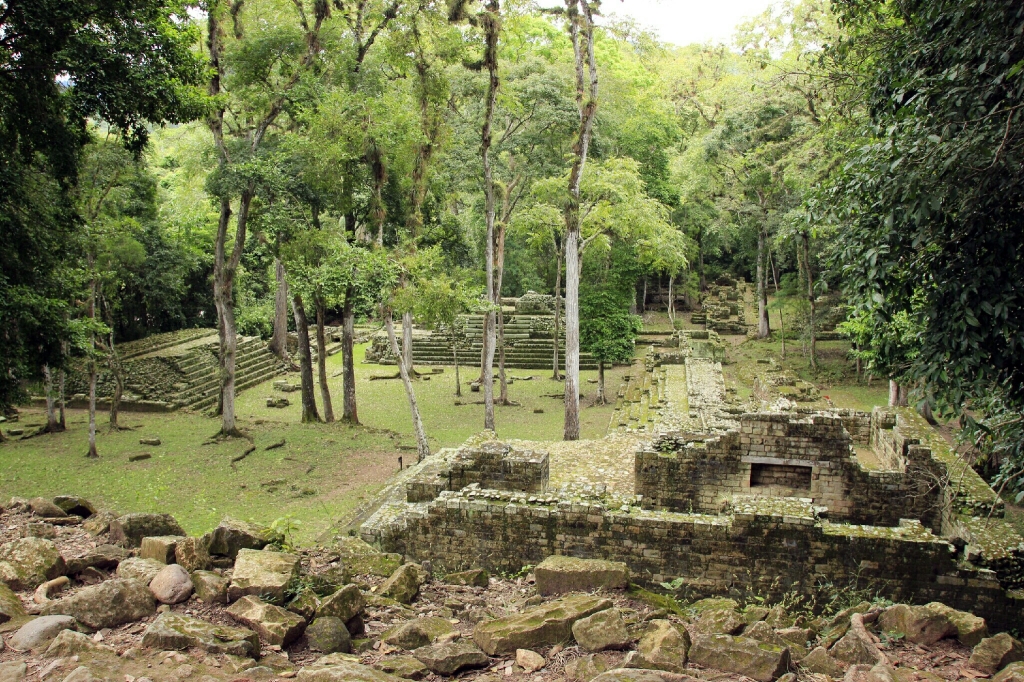
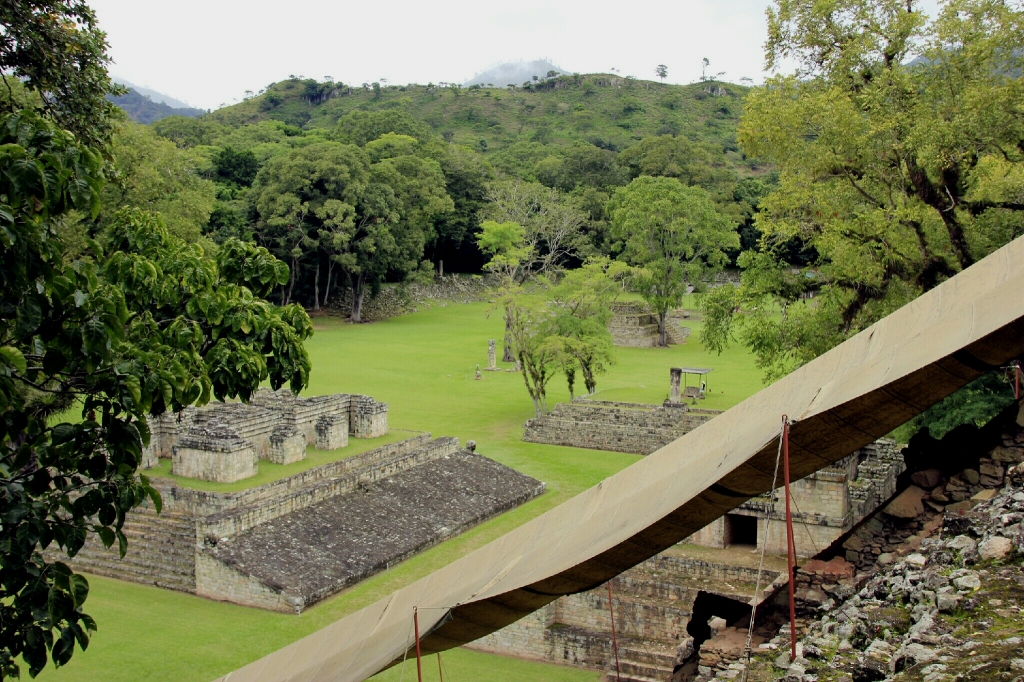
Apart from the name-giving ruins the town of Copan Ruinas is worth a visit itself. It was the first place in Honduras for us where we felt really comfortable and we experienced the people there to be very friendly and open. Often we were greeted by strangers on the streets and with some we even had the impression that they just were happy about us showing enough interest to come there. Just as on Utila there were Tuk-Tuks everywhere even of you could get everywhere on foot. What was a nice change to Utila or Nicaragua for that matter was that nobody tried obtrusively to sell you something in Copan Ruinas and even when you walked past the stalls of the souvenir vendors you were left alone. The employees in restaurants and bars were very nice and polite as well, there’s just the common central-american nuisance of them trying to take your order as soon as you sit and them whisking your plates away as soon as the last bite went into your mouth. We also noticed that Cowboy boots and hats seem to be the hottest fashion items with men there and that people in general were pretty small there. The latter might have to do with a lot of them being descendants of the Mayas since even today there’s roughly 6 million Mayas living in Central America.
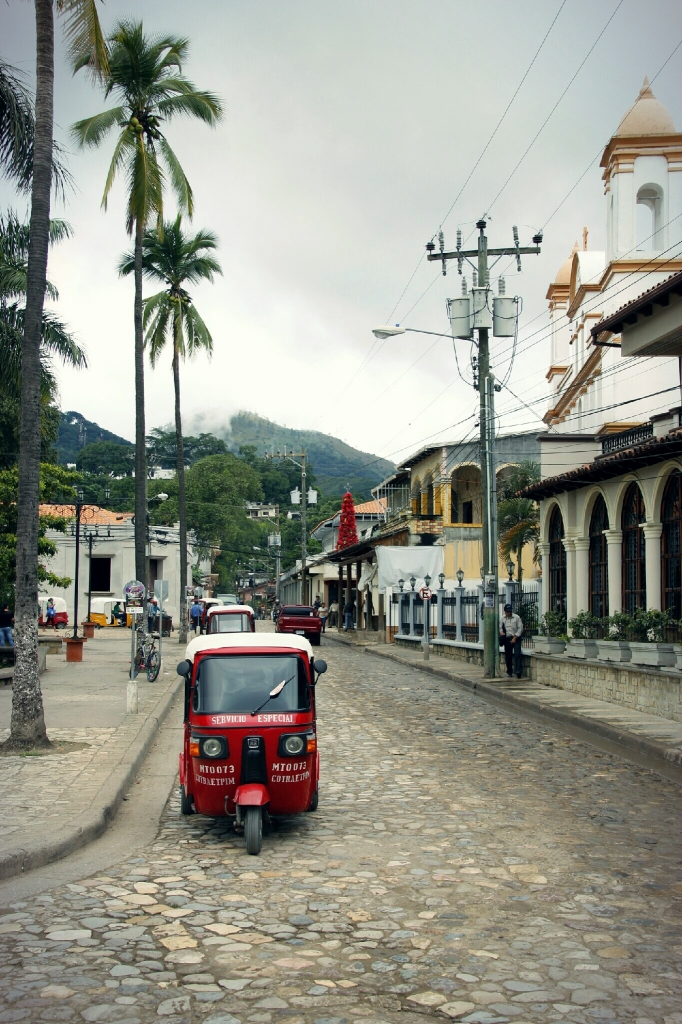
Copan was our last stop in Honduras and that means it’s time for another resume which is pretty short this time. Honduras was mostly a very expensive country for us which we find a bit unjustified. Until we came to Copan we didn’t like Honduras too much but we also have to point out that we really didn’t see much of it and might be wrong in that. Utila doesn’t really copunt since the influence from foreigners is so strong there, even if part of that even has historical reasons. The question of security often is at the foreground with Honduras. Of course you should just behave yourselves in a sensible way and watch out a bit and then try to not freak out about it. On the other hand you just can’t help but notice that security is an everyday topic there. A lot of locals talked about that without being prompted and warned us about this or that and apart from that you see guards and weapons everywhere. Even thsçe bus stations made you fell like you were in the Wild West – as soon as the bus is inside the gates are closed and an armed guard stands in front of them. All this makes it quite difficult to travel around in Honduras uninfluenced and lighthearted. About our high costs in Honduras we really shouldn’t complain about that. It it said to be the second-pporest country in Central America after all and we even took advantage of that by just going to Utila because learning to dive is allegedly nowhere cheaper than there. Another thing in that regard which we found to be dubious is that you almost never have to pay the V.A.T. as long as you don’t want to pay with a credit card or demand an invoice. On Utila somebody explained to us that this obvious and commonplace tax-evasion would be justified by the country not doing anything for it’s inhabitants.
We didn’t stay in Honduras for long and it took us just one and a half week to head on to Guatemala.
Deutsche Version
Nachdem wir entschieden hatten die Insel Utila wieder zu verlassen, bestiegen wir erneut die winzige Fähre und fuhren dieses Mal bei wesentlicher ruhigerer See zurück nach La Ceiba. Von dort traten wir eine weitere lange und teure Busreise in einem tiefgekühlten Bus nach Copan Ruinas an, das nur 12 km vor der Grenze zu Guatemala liegt. Laut Reiseführer soll es das kulturell wichtigste Reiseziel in Honduras sein, da dort die außergewöhnlichen Ruinen der Maya-Stadt Copan zu besichtigen sind. Diese liegen nur einen Kilometer entfernt vor den Toren des hübschen, kleinen Städtchens Copan Ruinas, das seinen Namen und seine Haupteinnahmequelle dem archäologischen Erbe seiner Maya-Vorfahren verdankt.
Copan lag am äußersten, südöstlichen Rand des Maya-Reiches und ist vor allem dafür berühmt, dass die dort gefundenen Stelen und Inschriften detaillierter und kunstfertiger sind als irgendwo sonst. Die Hochkultur der Maya selbst dürfte den meisten Menschen spätestens seit der unsinnigen Hysterie um einen Wendepunkt des Maya-Kalenders im Jahr 2012 ein Begriff sein. Manche kennen sie aber vielleicht auch als die Erfinder der Schokolade oder wegen ihrer Pyramiden oder Praxis der Menschenopfer. Kurioserweise kannten sie das Rad, benutzten es aber nicht und das obwohl es keinerlei Tiere gab, die sie als Lasttiere verwenden konnten. Die enormen Mengen von Stein für sämtliche ihrer Bauwerke wurden also ausschließlich von Menschenkraft bewegt. Die Maya kannten außerdem keine Bögen oder Gewölbe und daher wirken ihre Bauwerke insgesamt sehr eckig. Sogar bei ihren bildlichen Darstellungen kam uns einige Male der Gedanke, dass die darauf dargestellten Menschen ihre merkwürdigen, verrenkten Körperhaltungen nur hatten, damit sie in ein Rechteck hineinpassten.
Am Eingang der Ruinen von Copan wird man von Aras begrüßt, die dort früher sehr verbreitet waren und in der Architektur und Mythologie der Maya in Copan ebenfalls sehr präsent waren. Leider gibt es dort nicht mehr viele von ihnen, weswegen ein Projekt zur Wiederansiedlung dieser wunderschönen, großen Vögel ins Leben gerufen wurde. Bevor sie ausgewildert werden, erhalten sie im archäologischen Park regelmäßig Futter und sind so sehr an Menschen gewöhnt, dass man ihnen recht nahe kommen kann.
Die lokalen Führer, die man ebenfalls am Eingang des Ruinen-Parks antrifft und dort engagieren kann, tragen alle Stöcke bei sich, an die sie oben lange, bunte Federn angebunden haben, welche die Aras manchmal verlieren. Einer dieser Führer, der bereits sehr alt zu sein schien, wollte wissen wo wir herkommen und beeindruckte dann uns und seine beiden Kunden mit einigen Sätzen erstaunlich gutem Deutsch. Zu unserem Glück waren die Ruinen recht leer und die meisten Besucher stammten aus Honduras selbst, wie wir dem Gästebuch entnahmen.
Copan war ein Stadt-Staat, der etwa vom Jahr 250 bis um 900 existierte, als das Reich der Maya aus bisher ungeklärten Gründen plötzlich zusammenbrach. Die Ruinen seines Zentrums sind auch heute noch beeindruckend. In der Stadt selbst sollen zu Hochzeiten ca. 6000-9000 Menschen gelebt haben und im ganzen Tal von Copan insgesamt um die 25000. Die Herrscher dieses Reiches trugen mysteriöse, klangvolle Namen wie “Rauch-Jaguar” oder “Rauch-Muschel”, aber auch so verwirrende wie “18 Hase”, der auf vielen der Stelen dargestellt ist und für einige der wichtigsten Gebäude verantwortlich zeichnet. Es heißt zwar, dass die Sprache der Maya-Hieroglyphen heutzutage weitgehend entschlüsselt sei, aber man liest ebenfalls, dass einige der alten Texte bisher nur schlecht verstanden sind und gerade König 18 Hase ließ uns etwas daran zweifeln wie korrekt manche Übersetzungen sind. Bemerkenswert ist jedenfalls, dass die Maya bis zur Ankunft der Spanier das einzig bekannte, voll ausgeprägte Schriftsystem Amerikas besaßen. Die Besonderheit der Ruinen von Copan ist die große Hieroglyphen-Treppe, die in mehr als 2000 Zeichen die Geschichte der Stadt erzählt. Dies ist der längste Text der Maya, der bekannt ist und somit einzigartig auf der Welt. Leider hat ein Erdbeben im letzten Jahrhundert die meisten der Stufen losgerüttelt und man setzte sie danach falsch wieder zusammen. Archäologen versuchen nun immer noch mithilfe alter Fotografien den Text vollständig zu entschlüsseln.
Die Pyramiden der Maya dienten im Gegensatz zu den ägyptischen nur selten als Grabmal, sondern erfüllten vor allem kultische/religiöse Zwecke, z.B. als Opferstätten. Die Religion der Maya spielte eine zentrale Rolle in ihrem Leben und tatsächlich sind die meisten der Gebäude in Copan, deren Ruinen man heute noch sehen kann, keine Behausungen zum Wohnen gewesen, sondern hatten religiöse Bedeutung. Im Norden und Süden des Zentrums kann man allerdings Überreste von Gebäuden erkunden, in denen die Adelsschicht von Copan gelebt haben soll. Ein weiterer kleiner Fußmarsch von einem knappen Kilometer führt einen noch zu “Las Sepulturas”, wo ebenfalls Angehörige der oberen Schichten der Maya von Copan angesiedelt gewesen sein sollen.
Abgesehen von den namensgebenden Ruinen ist das Städtchen Copan Ruinas an sich ebenfalls einen Besuch wert. Es war der erste Ort in Honduras, an dem wir uns richtig wohl fühlten und wir erlebten die Menschen dort als sehr freundlich. Oft wurden wir auf der Straße von Fremden gegrüßt und bei manchen hatten wir das Gefühl, dass sie sich schlicht darüber freuten, dass wir interessiert genug waren herzukommen. Ebenso wie schon auf Utila gab es überall Tuk-Tuks obwohl man eigentlich alles zu Fuß erreichen kann. Im Gegensatz zu Utila oder auch Nicaragua versuchte in Copan Ruinas auch niemand einem etwas zu verkaufen und wenn man an den Ständen der Souvenir-Verkäufer vorbei ging, wurde man in Ruhe gelassen. Auch in Geschäften und Restaurants war das Personal sehr freundlich, nur herrscht auch dort wie überall in Zentralamerika die Unsitte, dass man die Bestellung aufnehmen will, sobald man sitzt und die Teller abräumt, sobald der letzte Bissen im Mund ist. Was uns außerdem auffiel war zum Einen, dass bei den Männern dort Cowboy-Stiefel und -Hüte der letzte Schrei zu sein schienen und, dass die Menschen insgesamt sehr klein sind. Das mag damit zusammenhängen, dass viele Nachfahren der Maya sind, denn auch heute noch leben in Mittelamerika knapp 6 Millionen Maya.
Copan war unsere letzte Station in Honduras und somit ist es wieder Zeit für ein Fazit über das Land. Dieses Mal fällt es aber kurz aus. Honduras erlebten wir vornehmlich als unverständlich teuer und bis wir nach Copan kamen, gefiel es uns auch nicht besonders. Wir haben allerdings auch wirklich nicht viel von dem Land gesehen und tun ihm wahrscheinlich unrecht. Utila zählt nicht so wirklich, denn der Einfluss von Ausländern ist dort allgegenwärtig, wenn auch teils sogar historisch bedingt. Der Sicherheitsaspekt steht im Zusammenhang mit Honduras meist im Vordergrund. Natürlich soll man sich dort einfach etwas umsichtig und nicht dumm verhalten und sich ansonsten nicht allzu sehr verrückt machen. Man kommt aber auch nicht umhin zu bemerken, dass Sicherheit ein großes Thema dort ist. Viele Einheimische sprachen es von sich aus an oder warnten uns vor diesem und jenem und davon abgesehen sieht man wie erwähnt überall Wachen und Waffen. Selbst die Bus-Stationen wirkten als wären sie in einem Krisengebiet gelegen, denn sobald der Bus eingefahren ist, werden die Tore geschlossen und eine Wache steht davor. Das alles macht es einem etwas schwer wirklich unbeschwert und unvoreingenommen durch dieses Land zu reisen.
Was unsere hohen Ausgaben in Honduras angeht, ist es zugegebenermaßen etwas verwerflich sich darüber zu beschweren. Immerhin soll es das zweitärmste Land Lateinamerikas sein und wir haben das sogar ausgenutzt, indem wir einzig deswegen nach Utila fuhren, weil man dort angeblich billiger an einen Tauchschein kommt als irgendwo sonst. Was wir in dem Zusammenhang ebenfalls fragwürdig fanden ist, dass man selten die Mehrwertsteuer zu bezahlen hat und oft nur dann wenn man von sich aus eine Rechnung verlangt oder mit Kreditkarte zahlen möchte. Auf Utila erklärte uns jemand, dass diese offenkundige, allgegenwärtige Steuerhinterziehung dadurch gerechtfertigt sei, dass der Staat auch nichts für die Menschen tun würde.
Wir hielten uns nicht sehr lange in Honduras auf und es dauerte insgesamt nur anderthalb Wochen bis wir nach Guatemala weiterzogen.
